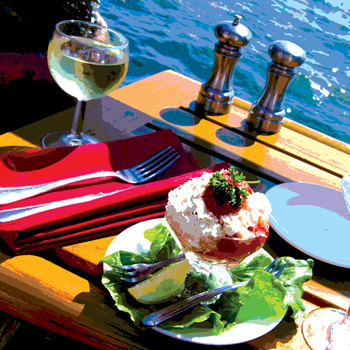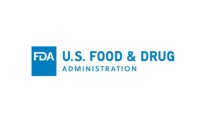FDA Regulation of Domestic Waterborne Transportation

The domestic waterborne transportation industry consists of a broad range of passenger vessels including commuter ferries, dinner cruise ships, and luxury cruise ships. Although there are a few large corporations with recognizable names in the business, the majority of the industry is comprised of small independent operators. U.S. Coast Guard data indicate that approximately 3,500 companies operate a total of almost 9,800 vessels.[1]
The nature of food service on these vessels varies from prepackaged drinks and snacks to freshly prepared gourmet meals to buffets open 24 hours a day, seven days a week. Just as food prepared on land is subject to food safety requirements, so is the food served on these vessels. Not only is the U.S. Food and Drug Administration (FDA) responsible for enforcing food safety regulations on these vessels, it is also responsible for enforcing regulations related to general sanitary conditions on the vessels, including compliance with certain design criteria. FDA jurisdiction and inspection responsibility for vessels is governed by the Federal Food, Drug, and Cosmetic Act, the Public Health Service Act, and the Passenger Vessel Services Act. FDA’s authority extends to U.S. flagged passenger vessels, combination passenger and cargo vessels, ferries and excursion vessels in interstate commerce.
This article presents the history of FDA’s regulatory responsibility over waterborne transportation and describes current regulations and practices that, if properly implemented, can significantly reduce both the incidence of foodborne and waterborne illness on U.S. flagged passenger vessels and the risk of transmission of communicable disease from state to state. Enforcement of these regulations is currently directed by FDA’s Center for Food Safety and Applied Nutrition (CFSAN).
History of Waterborne Transportation
In the latter part of the 1800s, epidemics of cholera, yellow fever and smallpox periodically emerged in various parts of the U.S. It was soon recognized that infected persons traveling or working on interstate passenger conveyances were spreading these diseases from community to community and from state to state. In February 1893, Congress amended the Public Health Service Act in an effort to minimize the spread of communicable diseases. The amendments granted the United States Public Health Service (then part of the Treasury Department) quarantine powers designed to prevent the introduction of contagious and infectious diseases from one state or territory to another state or territory. The Treasury Department promulgated the first Interstate Quarantine Regulations in September 1894 to implement the amendments to the Act. To enforce these regulations the Public Health Service depended not only on its own limited personnel, but also on the assistance of state health officials.
In 1911, among 235 passengers on a Great Lakes steamer, there were 122 cases of gastroenteritis and 42 cases of typhoid-like attacks, resulting in five deaths. In 1913, 144 cases of typhoid occurred among seamen working on Great Lakes vessels. In both situations the illnesses were traced to drinking water aboard the ships. As a result, the Public Health Service instituted a program designed to ensure that drinking water on vessels came from safe sources and was stored in contamination-free tanks. Several years later there was concern about the possibility of the plague entering the country via rats onboard U.S. vessels in foreign trade. Fumigation measures used to eliminate rats aboard ships were costly, time-consuming and had the potential to contaminate food being carried on the ship. Additionally, fumigation did little to prevent an infestation from recurring. The solution to this problem was to construct ships in a manner that reduced both the number of entry ways for rats and the number of places they could nest. This limited the rat population so fumigation would not be required. In 1917, the Public Health Service was given authority to develop and enforce vessel construction standards that would help improve the public health. By 1920, ratproofing construction specifications were developed and the Public Health Service began issuing Certificates of Sanitary Construction for ships that met the construction criteria.
On March 23, 1922, the Treasury Department issued Circular No. 282, which provided design and installation standards for onboard potable water systems. Unfortunately, this would not prevent all potable water problems. It soon became clear that additional requirements would be needed to ensure that the water being supplied to vessels was not contaminated. In 1943, at a West Coast shipyard, polluted water in the fire fighting water lines was forced into the potable water lines through a cross connection between the systems. As a result, 1,179 men became ill with gastroenteritis before the defect was found and corrected. Consequently, potable water systems must now be equipped with backflow prevention devices when cross-connections to non-potable systems exist.
In June 1969, many of the activities formerly associated with the Public Health Service were transferred to FDA. The actual transfer of regulations to FDA occurred in February 1975.
FDA’s Inspection Authority
Under Section 361 of the Public Health Service Act, FDA may inspect U.S. flagged vessels engaged in interstate traffic to prevent the introduction and transmission of communicable diseases. A “vessel” is defined in FDA regulations as any passenger-carrying, cargo, or towing ship except for fishing boats, tugboats that operate solely in local harbors, barges without self-propulsion, construction barges, and dredges.[2] The size, range and function of currently active passenger vessels is diverse. The vessels include 100-ton gaming and excursion boats leaving Florida waters for “cruises to nowhere” in international waters; the 300-passenger ferries running between Cape May, NJ and Lewes, DE; and 2,000-passenger cruise vessels traversing the tropical waters among the Hawaiian Islands. There are also 100-passenger mini-cruise vessels that navigate the Atlantic Coast’s Intracoastal Waterway, the coastal waters off New England, and the Great Lakes, as well as passenger-carrying riverboats that operate on major rivers like the Mississippi and Ohio Rivers in the Midwest and the Columbia River in the Northwest.
FDA regulations pertaining to interstate conveyance sanitation and control of communicable diseases are found in Title 21 Code of Federal Regulations (CFR) 1250 and 1240, respectively. These regulations outline the general requirements vessels must meet in order to minimize the likelihood that food and water on the vessel will become contaminated by pathogens, chemicals or pests. Compliance with these regulations is a critical element in vessel construction and often, the contract between a ship owner/operator and a shipbuilder stipulates as a condition of acceptance that the new-built or renovated vessel meet the requirements of the Public Health Service/FDA. As a result, FDA is involved in vessel construction from blueprint review through final inspection of the completed vessel. To assist in their evaluations, FDA investigators use a variety of references and guides to inspection, a host of nationally and internationally recognized third party standards, and the Public Health Service Handbook on Sanitation of Vessel Construction (PHS Publication No. 393), which is used primarily for smaller passenger vessels, ferries, and cargo ships.[3,4] The CDC’s Vessel Sanitation Program “Recommended Shipbuilding Construction Guidelines for Cruise Vessels Destined to Call on U.S. Ports” is used in the review of large cruise vessels that primarily operate in international service.
The evaluation process begins when the shipbuilder contacts the nearest FDA District Office and requests a review of the vessel’s blueprints and specifications. The builder then sends these materials to the designated FDA Interstate Travel Program (ITP) investigator who reviews drawings of the proposed systems for potable water, grey water, sewage (black water), drainage and ventilation. Drawings for the potable water system are scrutinized for potential cross-connections with nonpotable systems not equipped with backflow prevention devices at optimal locations. Calculations are made to determine if there is adequate production volume by the potable water evaporator and sufficient storage tank capacity for the number of crew and passengers. Similarly, sewage holding tanks must have sufficient storage capacity and the sewage treatment units must be certified by U.S. Coast Guard/International Maritime Organization as having adequate processing capacity and proper design for the maximum number of people allowed onboard. Diagrams and schematics of the grey water, sewage and drainage piping systems are examined to ensure the pipes are adequately separated from food and food contact surfaces, thus reducing the likelihood of contamination in the event of a leak.
In food storage and service spaces, specifications for food service equipment are compared against “approved” lists of equipment meeting applicable ANSI/NSF equipment standards or other equivalent standards. Layouts of food preparation, storage and service spaces are checked to ensure that plenty of hand washing opportunities exist and that food handling methods minimize the risk of contamination. Hazard Analysis and Critical Control Point (HACCP) principles are applied when reviewing these designs. Durability, cleanability and suitability of the deck covering and sheathing for bulkheads and ceilings is evaluated to ensure it is appropriate for food spaces. Lighting intensity and shielding above food preparation, storage, display and service spaces should be in accordance with FDA Food Code requirements.
Detailed drawings for ventilation fan rooms and any intake/exhaust ventilators in exposed deck areas should show that ratproofing and insect-proofing concerns are properly addressed. Air handlers in fan rooms as well as ventilation system ductwork must be accessible for cleaning and inspection to prevent these areas from becoming reservoirs for Legionella and organisms that cause Severe Acute Respiratory Syndrome (SARS) or other respiratory infections. Design details for solid waste storage, compaction, and incineration equipment for vessels are examined to determine whether vermin may find harborage and thrive in these spaces. On cruise vessels, proper design details for swimming pools, hot tubs and whirlpools should include the sizes and locations of drains and overflow gutters, water supply piping and adequate water turnover rates. Swimming pool and spa equipment room diagrams must include all filters, backflow prevention devices and halogenation equipment. Water, vapor and aerosols from the swimming pool, hot tub, whirlpool and other spa equipment may be sources of infection so these systems must be designed to maintain an adequate disinfectant residual in the water.
After the blueprint and specification review is completed, the FDA district office sends a letter to the engineering department at the shipyard that describes any deficiencies and requests additional information, if needed. If changes are required, revised blueprints and specifications are sent to FDA. Any questions or concerns that arise are typically addressed through meetings between FDA and the shipbuilding engineers. Once all issues are resolved, FDA sends the shipbuilder a letter stating that the design meets FDA’s sanitary construction requirements.
After the shipbuilding begins, FDA Interstate Travel Program investigators generally inspect the vessel at four stages of construction:
1. near the time of launch to determine proper location and installation of potable water tanks;
2. when refrigeration spaces are installed to verify ratproofing, potable water distribution piping and treatment, and drain/sewage piping;
3. while the galley is being installed to verify ratproofing, and to ensure that no sewage or drain piping is above the galley or other food spaces; and,
4. when the ship is completed and ready for delivery.
Many times “as built” construction does not reflect the original blueprints or equipment specification “cut” sheets.
Therefore, the FDA investigator must closely examine all areas covered by the blueprints and may need to conduct an onsite review of installed foodservice equipment. This usually focuses on backflow prevention, food spaces, foodservice equipment installation, routing of nonpotable piping, drain piping and ventilation.
FDA issues a Certificate of Sanitary Construction to the owners of the vessel after all significant construction deficiencies have been verified as corrected and water sampling shows that the potable water meets the EPA National Primary Drinking Water Quality Standards (40 CFR 141). After the vessel enters service, FDA conducts operational sanitation inspections. For these inspections FDA uses the guidelines set forth in the Food Code for all food spaces.[5] The inspection also covers maintenance of potable and nonpotable water systems, plumbing, ventilation, waste handling and vermin control. If the vessel passes the inspection, it is issued a Certificate of Sanitation.
In the event that violative sanitation or construction conditions are observed on the vessel, FDA has several regulatory options at its disposal. These options include issuing warning letters; seeking a temporary restraining order or permanent injunction; and collaborating with the U.S. Coast Guard to obtain a “no sail” order that prevents the vessel from leaving port with passengers.
FDA investigators who perform vessel construction and operational inspections are trained in the FDA Food Code and food service plan review. They are experienced in applying the information found in the Public Health Service/FDA Handbook on Sanitation of Vessel Construction and the Public Health Service/FDA Handbook on Sanitation of Vessels in Operation.[6] Familiarity with the CDC Vessel Sanitation Program’s cruise vessel construction guidelines and vessel operations handbook is recommended.
In addition to inspecting the vessels, FDA investigators perform inspections of vessel watering points. A vessel watering point is a facility located on a wharf or pier that loads potable water on vessels.[7] Only water from FDA approved watering points may be bunkered on vessels without additional onboard treatment in accordance with 21 CFR 1240.80.
New Challenges
The nature of the outbreaks, diseases, and conditions aboard passenger vessels that prompted the first vessel sanitation programs are somewhat different from those occurring today. Consequently, additional protective measures are needed to control current and emerging public health threats that could potentially affect the 900 million passengers who travel our nation’s waters for leisure and work each year.
Foodborne pathogens such as Salmonella and Campylobacter, as well as airborne pathogens causing Legionnaire’s disease, SARS and potentially avian flu, present challenges to the passenger transportation and hospitality industry. However, the most prevalent scourge to passengers and crew is the norovirus infection which causes acute gastroenteritis. Norovirus is transmitted through food and water, by person-to-person contact, and by environmental contamination. Investigations suggest that efforts to control gastroenteritis outbreaks on cruise ships should address all possible modes of norovirus transmission, including foodborne, environmental presence and persistence, and person to person spread. Successful mitigation measures include good food and water handling practices, extensive disinfection, isolating ill persons, providing paid sick leave for ill crew, and promoting handwashing with soap and water, followed by the use of a hand sanitizer. Developing strategies and incentives to dissuade symptomatic passengers from boarding vessels may also minimize opportunities to introduce new strains aboard. Even small gastroenteritis outbreaks on vessels should be considered for investigation because they may yield substantial information on the transmission and epidemiologic characteristics of the pathogens involved. This information can be used to develop control strategies and prevent future outbreaks on sea and land.[8]
The public health principles that prevent and protect passengers from communicable disease, and foodborne and waterborne infection, remain largely unchanged. By ensuring that vessel food and water supplies are safe, eliminating conditions by which contamination or pathogen growth can take place, and by taking basic sanitary precautions, the likelihood of passengers or crew becoming ill from food, water, or communicable disease is greatly reduced. The specific means by which these preventive measures are implemented has evolved over time as we learned more about pathogen control and as shipboard equipment changed. It is clear that consistently and proactively applying preventive measures results in far fewer illnesses than trying to contain an outbreak once it has begun.
Bon voyage, bien viaje…
Dean Davidson is the national manager for FDA’s Interstate Travel Program. He has worked in FDA field and headquarter offices for over 30 years and is a member of CFSAN’s Office of Compliance.
Bruce Kummer is the national technical advisor for FDA’s Interstate Travel Program. He has worked for FDA for more than 30 years and is a member of CFSAN’s Office of Compliance.
Series Editor Sebastian Cianci is a public affairs specialist and a member of CFSAN’s Office of Food Defense, Communication and Emergency Response, serving as the Center’s trade press liaison.
References
1. Food Service in the Interstate Conveyance Industry, August 2000, prepared by Jean L. Domanico and Donald W. Anderson Research Triangle Institute Center for Economics Research Research Triangle Park, NC.
2. 21 CFR 1240.3(p) and 21 CFR 1250.3(m).
3. Guide to Inspections of Interstate Carriers and Support Facilities. www.fda.gov/ora/Inspect_ref/igs/icsf.html.
4. Handbook on Sanitation of Vessel Construction: Standards of Sanitation and Ratproofing for the Construction
of Vessels. Public Health Service Publication No. 393, 1965 Revision
5. 2005 Food Code. www.cfsan.fda.gov/~dms/fc05-toc.html
6. Handbook on Sanitation of Vessels in Operation: Sanitation Features and Facilities on Vessels in Operation, Public Health Service Publication No. 68. Revised 1963.
7. Handbook on Sanitation of Vessel Watering Points: Design and Operation of Sanitation Facilities for Piers or Wharves Where Vessels Load Water. Public Health Service Publication No. 274. June 1963, p. iii.
8. Isakbaeva, Elmira T., et al. Norovirus transmission on cruise ship. Emerging Infectious Diseases, Vol 11, No. 1. January 2005.
Looking for a reprint of this article?
From high-res PDFs to custom plaques, order your copy today!








